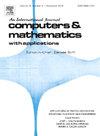一个易于实现的具有两个不同癌症亚群的癌症侵袭数学模型的数值框架
IF 2.5
2区 数学
Q1 MATHEMATICS, APPLIED
引用次数: 0
摘要
这项工作提出了一种有限元方案,用于解决涉及癌细胞亚群的模型。该模型由四个耦合的偏微分方程组成,分别代表肿瘤生长的演变、突变引起的癌细胞亚群的密度、细胞外基质(ECM)的密度和基质降解酶(MDE)的浓度。针对该模型建立了半隐式后向欧拉有限元框架。对所有变量建立了无条件误差估计,并证明了解的无条件稳定性。为了验证所提出的数值方案,我们进行了数值模拟,包括收敛速度的评估以及数值解和解析解之间的比较。本文章由计算机程序翻译,如有差异,请以英文原文为准。
An easy to implement numerical framework for a cancer invasion mathematical model with two distinct cancer sub-populations
This work presents a finite element scheme for solving a model that involves sub-populations of cancer cells. The model is formulated by four coupled partial differential equations, which represent the evolution of tumor growth, the density of cancer cell sub-populations arising from mutations, the density of the extracellular matrix (ECM), and the concentration of matrix-degrading enzymes (MDE). A semi-implicit backward Euler finite element framework has been developed for this model. Unconditional error estimates have been established for all variables, and the unconditional stability of the solutions has also been demonstrated. To validate the proposed numerical scheme, we have performed numerical simulations, including an assessment of the convergence rate and comparisons between the numerical solutions and analytical solutions.
求助全文
通过发布文献求助,成功后即可免费获取论文全文。
去求助
来源期刊

Computers & Mathematics with Applications
工程技术-计算机:跨学科应用
CiteScore
5.10
自引率
10.30%
发文量
396
审稿时长
9.9 weeks
期刊介绍:
Computers & Mathematics with Applications provides a medium of exchange for those engaged in fields contributing to building successful simulations for science and engineering using Partial Differential Equations (PDEs).
 求助内容:
求助内容: 应助结果提醒方式:
应助结果提醒方式:


